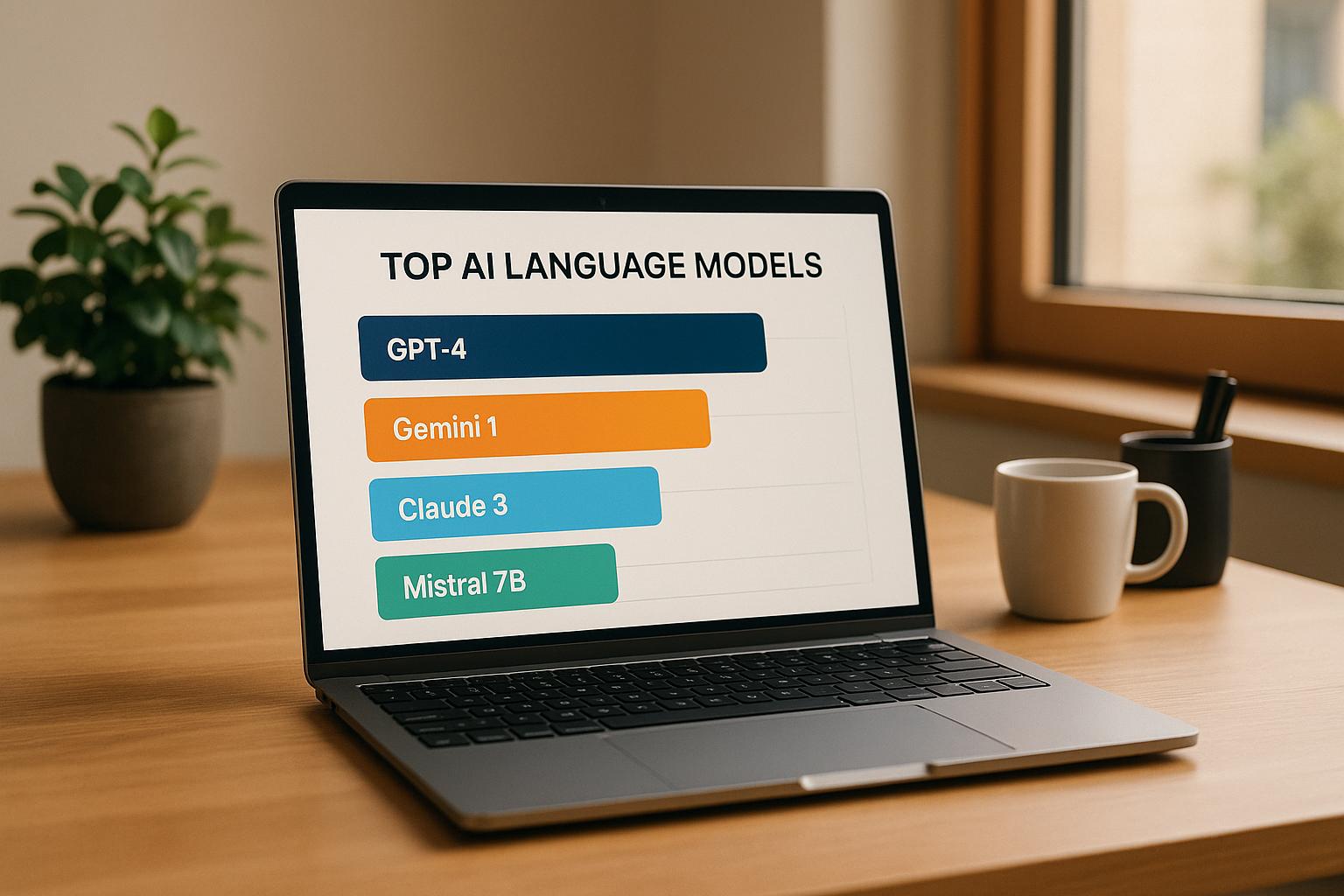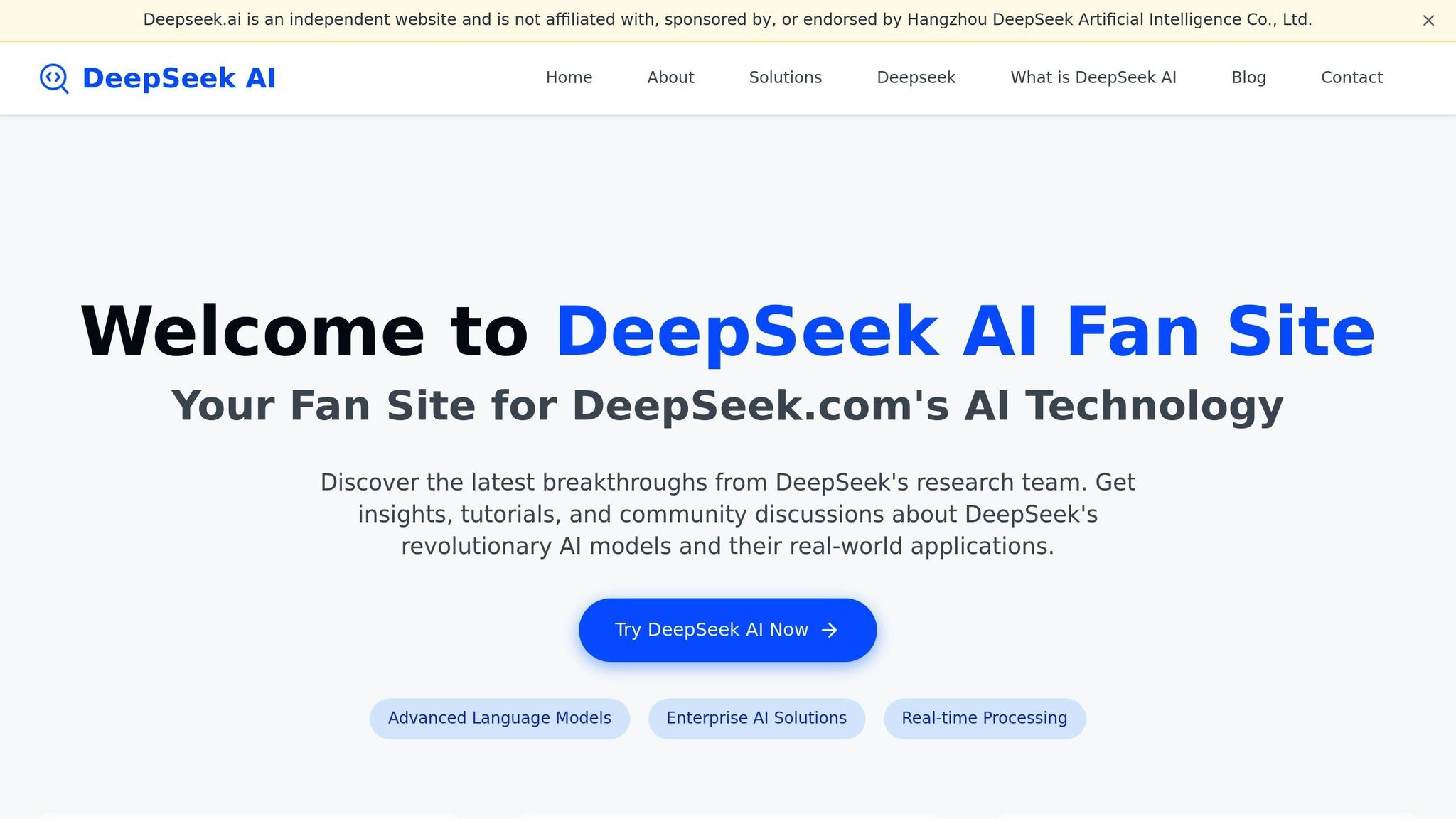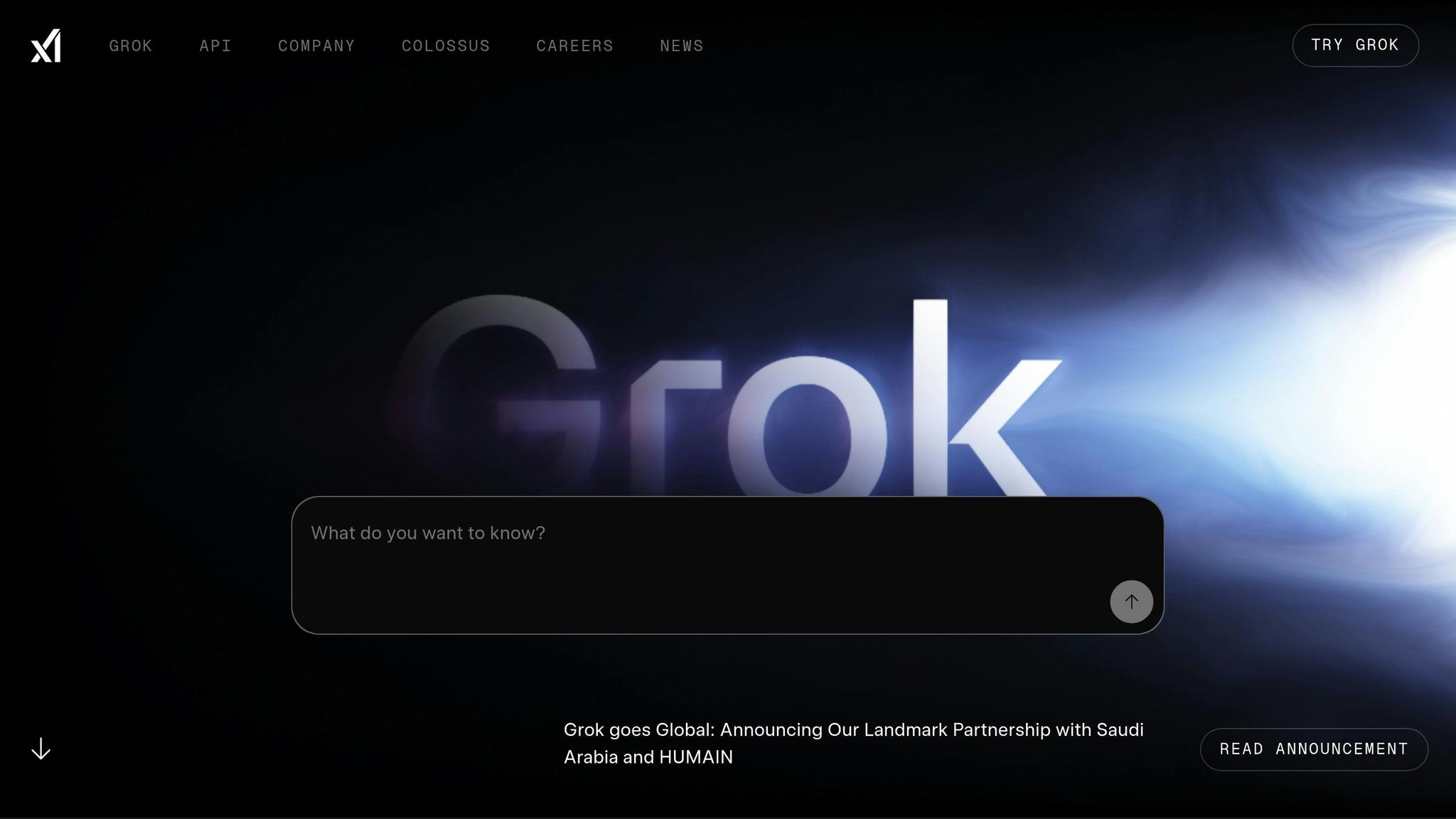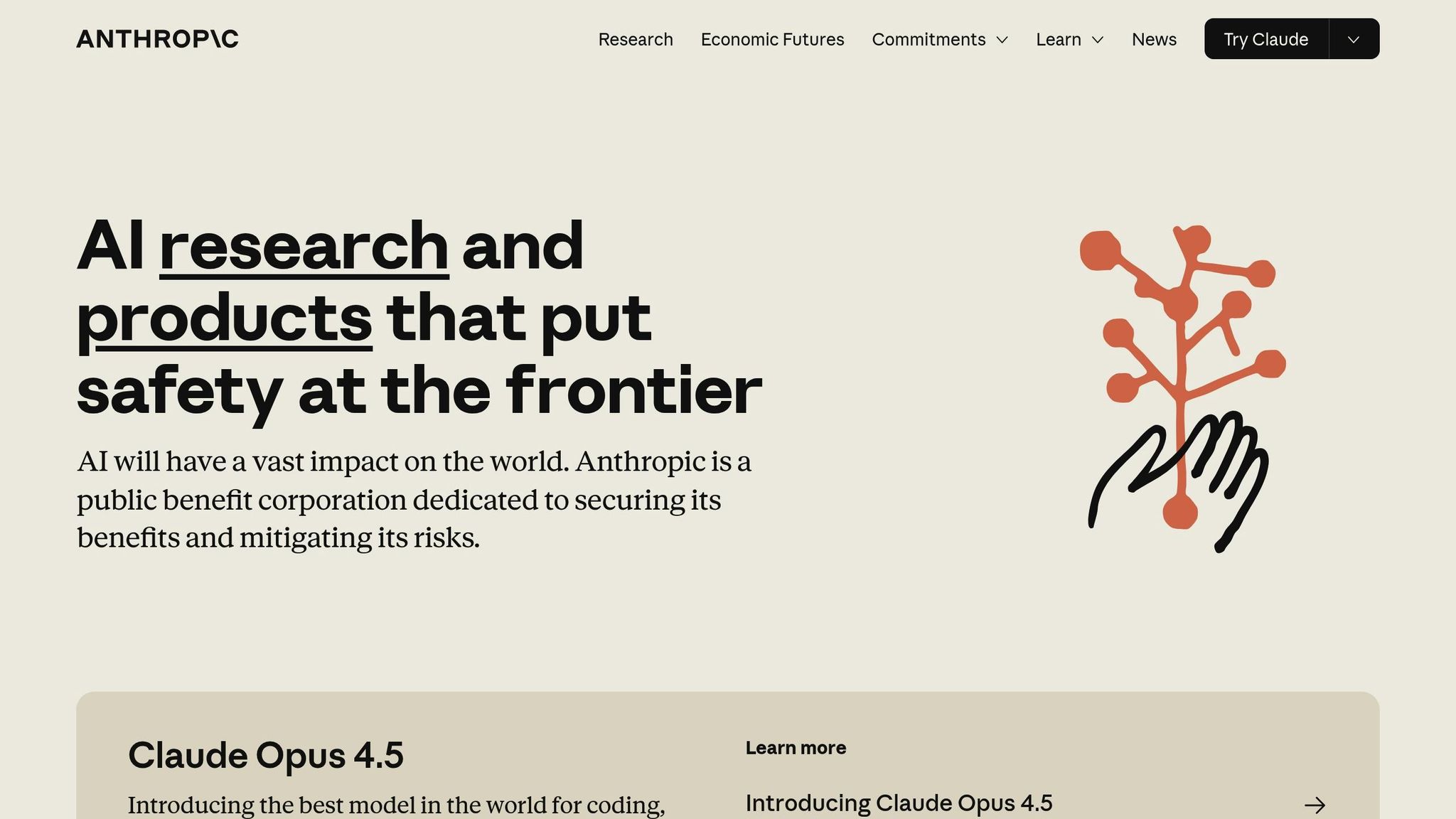
AI language models are transforming industries, but choosing the right one depends on your goals, budget, and technical needs. Here's a quick look at seven leading models and their focus areas:
Each model has strengths in areas like language processing, multilingual support, coding, and enterprise integration. Below is a quick comparison for better clarity.
| Model | Key Strengths | Use Cases | Current Limitations |
|---|---|---|---|
| OpenAI GPT-5 | Speculative improvements | TBD | No confirmed details available. |
| DeepSeek Series | Standard NLP tasks | General business needs | Sparse technical documentation. |
| Alibaba Qwen3 | Multilingual, Alibaba Cloud | Asian markets, enterprise workflows | Limited public benchmarks. |
| Grok by xAI | Real-time data, conversational | Creative tasks, brainstorming | Pending third-party evaluations. |
| Meta Llama 4 | Open-source, multilingual | Research, code generation | Requires technical expertise. |
| Anthropic Claude 4 | TBD | TBD | No official details available. |
| Google Gemini 2.5 | TBD | TBD | No official details available. |
Select a model based on your specific priorities - whether it's multilingual support, coding, or enterprise automation. Always check official updates and benchmarks for the latest insights.

Information about OpenAI's GPT-5 is still speculative, with no confirmed details available. While there’s plenty of buzz around potential advancements - such as enhanced reasoning, better performance, or multi-modal capabilities - none of these claims have been officially validated. It's important to approach early rumors with caution and rely on official updates from OpenAI for accurate information. Let’s now take a look at another prominent model.

Publicly available information on DeepSeek's latest language models is sparse, making it difficult to fully evaluate their capabilities. The details that are accessible suggest the company is focused on standard natural language processing (NLP) tasks like text generation, comprehension, and reasoning.
DeepSeek appears to concentrate on core NLP functionalities, including generating text, understanding language, and logical reasoning. However, the lack of technical details, such as specifications, performance benchmarks, or defining characteristics, limits the ability to compare these models to industry leaders or pinpoint their most effective use cases.
Specific advantages or unique design elements of DeepSeek's models remain unclear. The company has not provided substantial information about any architectural breakthroughs or distinguishing features that set their models apart.
Since performance benchmarks have not been shared, it is difficult to measure how DeepSeek's models stack up against competitors or established standards in the field.
Based on the limited data, these models seem to target general business needs and development scenarios. However, the absence of detailed documentation leaves their practical applications open to interpretation.
To provide better context, the following sections will compare AI systems with more thoroughly documented capabilities, offering insights into how DeepSeek's offerings might fit into the broader AI landscape.

Alibaba's Qwen3 represents the latest step in the evolution of Alibaba's AI language models, with a focus on multilingual functionality and integration within Alibaba's ecosystem of cloud and business services. While specific details about its architecture remain sparse, its potential applications are clear.
Qwen3 is designed to handle multilingual text processing, excelling particularly in Chinese and English. It supports tasks like text generation, summarization, question-answering, and even code generation in languages such as Python, JavaScript, and Java. Although comprehensive benchmark data is limited, the model is optimized to interpret context effectively in both conversational and formal writing scenarios.
These technical foundations pave the way for features that cater to enterprise needs.
A standout aspect of Qwen3 is its tight integration with Alibaba Cloud services, making it an attractive option for businesses already embedded in Alibaba's ecosystem. This seamless compatibility allows companies to incorporate the model directly into their workflows and applications without significant barriers.
The model also demonstrates a strong focus on understanding local linguistic nuances, which is particularly useful for businesses operating in regions where cultural and contextual accuracy in communication is critical.
Additionally, Qwen3 appears to prioritize enterprise security, though detailed information on its data handling and privacy protocols has not been extensively outlined in public materials.
These features collectively position Qwen3 as a valuable tool for enterprise automation and localized content management.
While detailed performance metrics for Qwen3 are scarce, available data suggests it performs well on standard language benchmarks. Early feedback highlights its strength in Chinese-language tasks, where it may outperform Western-developed models. However, more extensive testing and evaluation are needed to fully understand its competitive standing.
Qwen3's capabilities make it particularly appealing for businesses targeting Asian markets or those requiring robust Chinese language support. Its deep integration with Alibaba Cloud infrastructure further enhances its appeal for companies already using Alibaba's services.
The model is especially suited for content localization efforts, such as adapting materials for Chinese-speaking audiences or managing multilingual customer support. Its ability to grasp regional and contextual nuances makes it a strong candidate for marketing and communication tasks.
Additionally, Qwen3 is well-positioned for enterprise automation, particularly for organizations already invested in Alibaba's broader business ecosystem. Its combination of multilingual capabilities and enterprise-focused features ensures it can address a wide range of operational needs.

Grok by xAI stands out for its focus on conversational interaction and its ability to access real-time data.
Grok is equipped to handle a variety of tasks, including generating text, writing code, solving mathematical problems, and engaging in dialogue. Its training prioritizes natural, conversational exchanges, making it capable of informal yet productive interactions.
One of Grok's strengths is its ability to provide up-to-date information, addressing the common limitation of fixed knowledge in many AI models. It combines this with a conversational style that feels engaging and approachable, enhancing the user experience across different tasks.
While Grok shows strong potential and performs well in various areas, independent third-party evaluations of its capabilities are still pending. As a result, its full performance across diverse applications is yet to be fully understood.
Grok is particularly well-suited for users seeking flexible and less formal AI interactions. It shines in tasks like creative writing, brainstorming, and exploratory conversations, where a casual and dynamic dialogue style is preferred. Its approach adds a unique dimension to the competitive AI landscape, complementing the capabilities of other models in the field.

Meta Llama 4 continues Meta's commitment to open-source AI by providing a highly adaptable language model tailored for developers and researchers.
Meta Llama 4 excels in handling multilingual tasks and generating code. It efficiently processes longer texts, making it an excellent choice for tasks like document summarization, research assistance, and technical writing. The model is designed with a focus on sequential reasoning, enabling it to break down complex problems into smaller, more manageable steps - perfect for educational and analytical purposes. These strengths make it a versatile tool for a wide range of industries.
One of the standout features of Meta Llama 4 is its open-source framework, which allows users to customize the model freely without licensing restrictions. It also includes built-in safety measures and a modular design, making it adaptable for tasks such as creative writing and technical documentation.
Meta Llama 4 is optimized for diverse language tasks, delivering consistent and efficient performance. Its design strikes a balance between computational efficiency and reliable output, making it accessible even for organizations with limited hardware capabilities.
Meta Llama 4 is well-suited for applications like internal chatbots, document processing, automated workflows, and educational research. Software development teams can leverage its strengths for tasks like code generation and debugging, addressing a variety of industry-specific needs.

At this time, there are no confirmed details about the capabilities, features, performance, or potential use cases of Anthropic Claude 4. As more information becomes available, this section will be updated to reflect the latest insights.
At this time, there’s no official information available regarding the capabilities, features, performance, or potential applications of Google Gemini 2.5. Updates will be provided as soon as new details are released, reflecting the evolving nature of emerging models in the industry.
When evaluating AI language models, it's essential to weigh their strengths and limitations. These models come with inherent trade-offs, and their performance often depends on the specific use case. While technical specifications and reviews are regularly updated, here are some common factors to keep in mind:
As AI technology evolves, it's always a good idea to consult the latest official documentation and trusted performance reviews to make informed decisions based on the most up-to-date information.
Choosing the right AI language model hinges on how well its capabilities align with your specific goals and requirements. Each model brings distinct advantages to the table, making it essential to weigh your priorities carefully.
For enterprise automation, Anthropic Claude 4 and Grok by xAI show potential in streamlining business workflows, though their full capabilities are still being evaluated. If multilingual support is a priority, Alibaba Qwen3 stands out with its expertise in Chinese language performance and regional applications.
When it comes to content creation, OpenAI GPT-5 - once released - may offer cutting-edge tools, while Meta Llama 4 provides a flexible, open-source option ideal for developers and researchers seeking customization. The DeepSeek Series covers standard NLP tasks, though more data on its performance would provide greater clarity.
For tasks requiring real-time information access, Grok by xAI excels with its conversational capabilities and up-to-date data integration. Meanwhile, Google Gemini 2.5 remains a highly anticipated choice, with further details expected upon its official release.
If budget constraints are a concern, Meta Llama 4's open-source framework offers extensive control without licensing fees. Similarly, Alibaba Qwen3 provides excellent value for businesses already utilizing Alibaba Cloud services.
Ultimately, your selection should reflect your specific needs - whether it’s processing speed, language capabilities, infrastructure compatibility, or scalability. Align these factors with each model's documented strengths, and consider your long-term objectives and resources to make an informed decision.
Choosing the right AI language model for your business requires careful consideration of several factors. Begin by pinpointing your specific needs - whether you're looking to enhance content creation, improve customer support, streamline coding, or tackle advanced natural language tasks. Once you’ve outlined your priorities, assess models based on their capabilities, such as handling complex challenges, processing multimodal inputs (like combining text and images), or offering specialized features tailored to your industry.
Budget is another key factor. Weigh the cost of the model against your financial constraints and decide whether you prefer the adaptability of open-source platforms or the high performance of proprietary options. For businesses focused on seamless integration, ensure the model offers API access, making it easier to incorporate into your existing workflows. By aligning these elements with your business objectives, you’ll be better equipped to choose the AI solution that delivers the results you need.
When choosing an AI language model, it's essential to weigh several key factors. Start by examining its capabilities, such as how well it handles accuracy, reasoning, and whether it supports multimodal inputs like text and images. The context window size is another critical element, as it determines how much data the model can process simultaneously. Additionally, explore its integration options, including APIs and customization tools that align with your workflow.
Pay close attention to performance metrics like speed and latency, as these can impact efficiency, especially during complex or lengthy tasks. Consider the model's cost efficiency to ensure it fits within your budget. Equally important are its safety features and ethical safeguards, particularly for sensitive or high-stakes applications. By evaluating these aspects, you can select a model tailored to your needs, whether you're focusing on content creation, automation, or advanced natural language understanding.
There’s not much available on models like GPT-5 and Google Gemini 2.5 yet. This is likely because they’re still in development, tightly guarded under confidentiality agreements, or haven’t been widely released. Companies often keep these details under wraps to safeguard their intellectual property and shape public perception strategically.
For now, it’s smarter to stick with models that have a solid track record and thorough documentation, especially for important tasks. While it’s worth staying updated on advancements, focus on tools that are already tested and reliable for your current needs.


